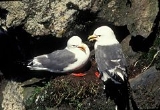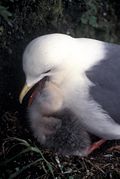
Red-legged Kittiwake
Encyclopedia
The Red-legged Kittiwake (Rissa brevirostris) is a seabird
species in the gull
family Laridae. It breeds in the Pribilof, Bogoslof and Buldir islands of the USA, and the Commander Islands, Russia. Adults are 35–40 cm (13.8–15.7 in) long, with an 84–92 cm (33.1–36.2 in) wingspan and a body mass of 325–510 g (11.5–18 oz).
 The Red-legged Kittiwake is a very localised subarctic
The Red-legged Kittiwake is a very localised subarctic
Pacific species. Apart from the distinguishing feature implicit in its name, it is very similar to its better known relative, the Black-legged Kittiwake
; other differences include the shorter bill, larger eyes, a larger, rounder head and darker grey wings, and in the juveniles, which barely differ from the adults, lacking the black tail band and 'W' across the wings of juvenile Black-legged Kittiwakes. Juveniles take three years to reach maturity.
Like the Pacific race of Black-legged Kittiwake, the Red-legged Kittiwake has a well-developed hind toe. As occasional individual Black-legged Kittiwakes have reddish legs, any reports of Red-legged away from the subarctic Pacific must record all of the other differences, not just the leg colour, for acceptance by bird recording authorities.
This species is classed as vulnerable since it has a limited population (291,000 - 321,000) and range (1,740 km²), and its numbers decreased by c.35% between the mid-1970s to mid-1990s.
Seabird
Seabirds are birds that have adapted to life within the marine environment. While seabirds vary greatly in lifestyle, behaviour and physiology, they often exhibit striking convergent evolution, as the same environmental problems and feeding niches have resulted in similar adaptations...
species in the gull
Gull
Gulls are birds in the family Laridae. They are most closely related to the terns and only distantly related to auks, skimmers, and more distantly to the waders...
family Laridae. It breeds in the Pribilof, Bogoslof and Buldir islands of the USA, and the Commander Islands, Russia. Adults are 35–40 cm (13.8–15.7 in) long, with an 84–92 cm (33.1–36.2 in) wingspan and a body mass of 325–510 g (11.5–18 oz).

Subarctic
The Subarctic is a region in the Northern Hemisphere immediately south of the true Arctic and covering much of Alaska, Canada, the north of Scandinavia, Siberia, and northern Mongolia...
Pacific species. Apart from the distinguishing feature implicit in its name, it is very similar to its better known relative, the Black-legged Kittiwake
Black-legged Kittiwake
The Black-legged Kittiwake is a seabird species in the gull family Laridae.This species was first described by Linnaeus in his Systema naturae in 1758 as Larus tridactylus....
; other differences include the shorter bill, larger eyes, a larger, rounder head and darker grey wings, and in the juveniles, which barely differ from the adults, lacking the black tail band and 'W' across the wings of juvenile Black-legged Kittiwakes. Juveniles take three years to reach maturity.
Like the Pacific race of Black-legged Kittiwake, the Red-legged Kittiwake has a well-developed hind toe. As occasional individual Black-legged Kittiwakes have reddish legs, any reports of Red-legged away from the subarctic Pacific must record all of the other differences, not just the leg colour, for acceptance by bird recording authorities.
This species is classed as vulnerable since it has a limited population (291,000 - 321,000) and range (1,740 km²), and its numbers decreased by c.35% between the mid-1970s to mid-1990s.

